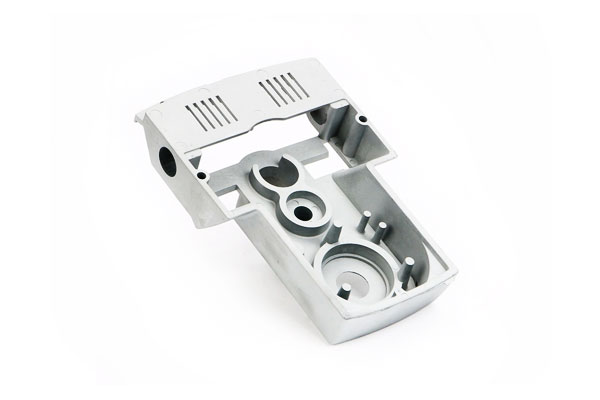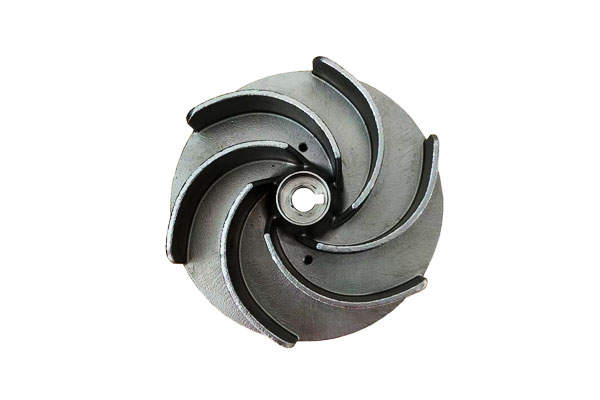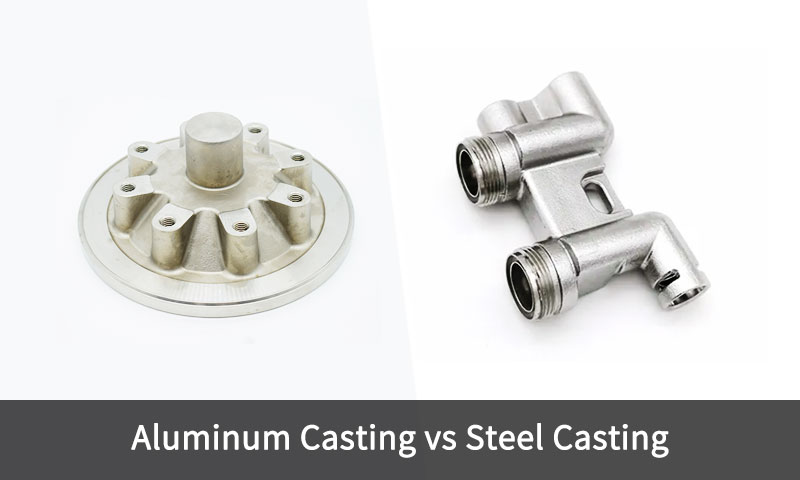1. Hōʻikeʻike
Aluminum vs Steel Casting — choosing between these two foundational materials shapes component performance, cost and manufacturability across industries from automotive to energy.
This comparison is not merely about metal chemistry: it encompasses density and stiffness, Kauhini, casting process compatibility, secondary processing (ʻO ka hana wela, Kālā papaaina), lifecycle cost and application-specific reliability.
Engineers and purchasers must therefore evaluate the entire system—loading, keka ao, environment, production volume and finish requirements—before specifying a metal and casting route.
2. Fundamental Material Differences Between Aluminum vs Steel
At the core of aluminum vs. steel casting lies a fundamental metallurgical and physical contrast that directly affects how each material behaves during casting, machining, a lawelawe.
| Waiwai | Aluminum (E.g., Al-i allays) | Kukui Kekuhi (E.g., carbon or low-alloy steels) | Engineering Implications |
| Huakai (g / cm³) | 2.70 | 7.85 | Aluminum is ~65% lighter, offering major weight savings for transportation and aerospace. |
| Malting Point (° C) | 615-660 | 1425–1540 | Aluminum’s low melting point enables easier casting and lower energy consumption; steel requires specialized furnaces. |
| Ka HōʻaʻO Kokua (W / m · c · k) | 120-180 | 40-60 | Aluminum dissipates heat efficiently—ideal for engines, nā mea hana wela, a me na uila. |
| Ikaika kiko'ī (MPa/ρ) | ~100–150 | ~70–90 | Despite lower absolute strength, aluminum’s strength-to-weight ratio surpasses that of steel. |
| Elastic Modulus (GPA) | 70 | 200 | Steel is stiffer, providing better rigidity under load and vibration. |
Ke kū'ē neiʻo Corrosionion |
Kūpono (forms Al₂O₃ layer) | ʻAnoʻano; prone to rust without coatings | Aluminum resists oxidation naturally, while steel needs surface protection (Kāleka, Wehe, or alloying with Cr/Ni). |
| Markinpalibility | Kūpono | Moderate to difficult | Aluminum’s softness allows easy machining and shorter cycle times; steel requires tougher tooling. |
| Recyclabiality | >90% recoverable | >90% recoverable | Both materials are highly recyclable, though aluminum’s remelting requires less energy (5% of primary production). |
| Casting Shrinkage (%) | 1.3-1.6 | 2.0–2.6 | Steel shrinks more during solidification, demanding larger allowances and more complex gating/feeding systems. |
| Kālā (kokoke., USD/kg) | 2.0-3.0 | 0.8-1.5 | Aluminum is more expensive per kilogram, but savings in weight and processing can offset total lifecycle costs. |
3. What Is Aluminum Casting?
Aluminum Kauhi is the process of shaping molten aluminum or aluminum alloys into complex, near-net-shape components using molds.
It is one of the most widely used metal casting processes globally—accounting for over 50% of all nonferrous castings—due to aluminum’s excellent castability, haʻahaʻa haʻahaʻa, a me ke kū'ēʻana.

Hōʻuluʻike
In aluminum casting, monten aluminum (ma waena 680–750°C) is poured or injected into a mold cavity where it solidifies into the desired geometry.
Aluminum’s low melting point and high fluidity make it ideal for both mass-production methods (like die casting) and nā noi kūpono kūpono (like investment casting).
Key Features of Aluminum Casting
- ʻO ka māmā a me ke kiʻekiʻe ikaika-kiʻekiʻe-kiʻekiʻe-kiʻekiʻe:
Aluminum castings offer excellent mechanical performance while being about Hoʻokahi-ʻekoluʻekolu o ke kaupaonaʻana. - ʻO ke kū'ēʻana o ka corrossion maikaʻi:
He lahui, ke ho'ōla nei aluminum oxide layer (Al₂o₃) protects against oxidation and most atmospheric or marine corrosion. - Maikaʻi maikaʻi a me ke ola uila:
Suitable for applications like nā mea hana wela, urowing, and electric components. - Recyclabiality:
Aluminum can be recycled indefinitely without degradation, reducing production energy by up to 95% compared to primary smelting.
Common Aluminum Casting Processes
| Ke Kūleʻa Kūlana | ʻO ka weheweheʻana | Nā noi maʻamau |
| Hoolei Make | High-pressure injection of molten aluminum into steel dies; yields precise, nā'āpana'āpana. | Nā'āpana automothetive (nā holohaʻana, nā brackets), mea uila. |
| Sand cread | Molten metal poured into sand molds; suitable for larger, lower-volume parts. | Nā poloka mīkini, MatifalD, aieerorcace home. |
| Hoʻolei kālā | Ceramic molds from wax patterns; ideal for fine details and tight tolerances. | ʻO nā hale o Aerospace Turbine, Nā Pūnaewele Pūnaewele. |
| Ke hoʻomau mau nei | Reusable metal molds; good surface finish and dimensional control. | Picsons, huila, a me nā mea'ē aʻe. |
| ʻO Centricugual kāhea | Uses centrifugal force to distribute molten metal; huakai, defect-free frecture. | Tubes, moe 'ana, and rings. |
Loaʻa nā pono o ke kāwele a Alminum
- Māmā māmā: Reduces component weight by 30-50% vsa. Kukui Kekuhi, improving fuel efficiency (aitompetitive) or payload capacity (AerERPPACE).
- Ka hoʻoikaika: Melting aluminum requires 60–70% less energy than steel (570° C vs. 1420° C), lowering processing costs by 20-30%.
- Ke kū'ē neiʻo Corrosionion: Eliminates the need for coatings (E.g., pehi, garvalirigigling) I ka nui o nā wahi, reducing maintenance costs by 40-50%.
- High-Volume Viability: Die casting enables production of 1000+ parts/day per machine, meeting consumer goods demand.
Disadvantages of Aluminum Casting
- Ikaika ikaika: Ikaika ikaika (150-400 MPPA) is 50–70% lower than high-strength steel, limiting use in heavy-load applications.
- Poor High-Temperature Performance: Retains only 50% of room-temperature strength at 250°C, making it unsuitable for engine exhaust or power plant components.
- He pilikia prostity: Die-cast aluminum is prone to gas porosity (from high-pressure injection), restricting heat treatment options (E.g., T6 temper requires vacuum processing).
- Higher Raw Material Cost: Primary aluminum costs $2,500–$3,500/tonne, 2–3x more than carbon steel.
Industrial Applications of Aluminum Casting
Aluminum casting is widely used across multiple industries due to its combination of makana māmā, markinpalibility, a me ke kū'ēʻana:
- Kaʻa kaʻa: Nā poloka mīkini, nā hale paʻi kiʻi, huila, and suspension arms.
- Aerospace: Nā brackets, hana kūpono, ʻO nā mea hoʻonani.
- Mea uila: Sinks wela, Nā Mālama Poole, nā pā.
- Nā huahana kūʻai: Nā hana hana, 'Āpana papa, mea uila.
- Marine and Renewable Energy: Huakai, urowing, aʻo nā'āpana turbine.
4. What Is Steel Casting?
Steel casting is the process of pouring molten steel into a mold to produce complex, high-strength components that cannot be easily fabricated or forged.
Unlike aluminum, steel has a ʻO ke kuhikuhiʻana i ke ala kiʻekiʻe (≈ 1450–1530°C) and greater tensile strength, He kūpono kūpono no ka load-bearing and high-temperature applications such as machinery, infrastructure, a me ka mana.

Hōʻuluʻike
In steel casting, carefully alloyed molten steel is poured into either expendable (Sand, waiwai kūʻai) or permanent molds, where it solidifies into a shape close to the final part.
Because steel shrinks significantly upon cooling, precise temperature control, hoʻolālā hoʻolālā, and solidification modeling he koʻikoʻi.
Steel castings are known for their Mechanical, hopena kū'ē, a me keʻano kūlike, particularly under harsh service conditions.
Key Features of Steel Casting
- Exceptional Strength and Toughness:
Yield strengths often exceed 350 Mpa, with heat-treated alloys reaching over 1000 Mpa. - High-Temperature Capability:
Retains strength and oxidation resistance up to 600–800°C, depending on composition. - Versatile Alloy Selection:
Includes Nā Kahu Pūnaewele, nā puʻu haʻahaʻa haʻahaʻa, nā mea kanu lāʻau, and high-manganese steels, each tailored for specific environments. - WELLLIKIE MA KA:
Cast steels can be post-processed effectively—machined, welded, and heat-treated to enhance performance.
Common Steel Casting Processes
| Ke Kūleʻa Kūlana | ʻO ka weheweheʻana | Nā noi maʻamau |
| Sand cread | Molten steel poured into bonded sand molds; Kūpono no ka nui, nā'āpana paʻakikī. | Nā kino valve, Nā kāpili pump, machinery housings. |
| Hoʻolei kālā | Ceramic molds formed from wax patterns; yields excellent accuracy and surface finish. | Nā'āpana o Turbine, Nā Hana Hana Kūʻai, Nā Māhele kā Aerospace. |
| ʻO Centricugual kāhea | Rotational force distributes molten steel evenly; produces dense cylindrical components. | Pipes, liners, E hali ana i nā lāhui. |
| Nā pāpale pīpī pale | Uses thin resin-coated sand molds; allows higher precision and smoother surfaces. | Nā'āpana liʻiliʻi liʻiliʻi, nā brackets. |
| Ke hoʻomau nei | For semi-finished steel products like slabs and billets. | Raw material for rolling and forging. |
Advantages of Steel Casting
- Ikaika ikaika & Paʻakikī: Ikaika ikaika (a i 1500 Mpa) a hopena i ka paʻakikī (40–100 J) make it irreplaceable for structural safety (E.g., ʻO nā'āpana halima, ʻO Chassis Chassis).
- ʻO ka hana kiʻekiʻe kiʻekiʻe: Operates reliably at 400-600 ° C (vsa. aluminum’s 250°C limit), suitable for jet engine casings and power plant boilers.
- Low Raw Material Cost: Carbon steel costs $800–$1200/tonne, 60–70% less than primary aluminum.
- E kāʻei i ke kū'ē: Heat-treated steel (E.g., 4140) has surface hardness up to 500 HB, reducing replacement frequency in abrasive applications by 50-70%.
Disadvantages of Steel Casting
- High Weight: Density 2.7x that of aluminum increases fuel consumption (aitompetitive) or structural load (buildings).
- High Energy Use: Melting steel requires 25–30 MWh/tonne (vsa. 5–7 MWh/tonne for aluminum), increasing processing costs by 40-50%.
- Corrosione corrosion: Carbon steel rusts in moist environments (Pahuikawa: 0.5-1.0 mm / makahiki in salt spray), requiring coatings (E.g., garvalirigigling) that add $1.5–$2.5/kg to costs.
- Poor Machinability: Hardness requires specialized tools, ka hoʻonuiʻana i ka manawa ma ka manawa 30-50% vsa. aluminum.
Industrial Applications of Steel Casting
Steel castings dominate industries demanding ikaika, durability, a me ke kū'ēʻana:
- Kūkulu hoʻi & Mining: Excavator teeth, nā'āpana crusher, track links.
- Ikaika & Mana pā'āʻu: Steam turbine casings, nā kino valve, nā'āpana nulear.
- Pono & Aila: Drill heads, pipeline valves, MatifalD.
- Kaʻahele: Train couplers, nā holohaʻana, heavy-duty engine blocks.
- Aerospace & Reflan: Nā Kūlana Kūlana, hana kūpono, armor components.
5. ʻO nā hoʻohālikelike hoʻohālikelike: Aluminum vs Steel Casting
Process fit and part geometry
- Laki, paʻakikī, nā'āpana nui: aluminum die casting is optimal (HPDC).
- Nui, mea prheys, load-bearing parts: steel/spheroidal graphite (ʻO Dāhihi) iron and cast steels via sand casting are preferred.
- Medium volume with high integrity requirements: low-pressure aluminum or investment casting steels depending on strength needs.
Mechanical performance & post-ho'ōla
- ʻO ka hana wela: cast steel can be quenched & tempered to obtain high strength and toughness; aluminum alloys have age-hardening routes but reach lower maximum strengths.
- Surface engineering: aluminum readily anodizes; steel can be nitrided, carburized, induction hardened or coated with hard substances (Nā Kūlana, ʻO BRROMY HARD).
Nā Kūlana Kūʻai (typical considerations)
- Material cost per kg: aluminum raw metal tends to be priced higher per kg than ferrous scrap/steel, but part mass reduces required amount.
- Hoao: die casting dies are expensive (high initial amortization) but low per-part cost at volumes >10k–100k; sand tooling is cheap but per-part labor higher.
- Machimen: aluminum machines faster (higher removal rates), lower tool wear; steel requires harder tooling and more machining time—raises total cost especially for small batches.
Mea hana & defect modes
- Potiwale: HPDC aluminum can develop gas and shrinkage porosity; permanent-mold and low-pressure reduce porosity.
Steel castings can suffer inclusions and segregation; controlled melting and post-HT reduce defects. - ʻO ka hoʻokeleʻo Dimensonal: die cast aluminum attains tight tolerances (± 0.1-0.3 mm); sand cast steel tolerances are looser (±0.5–2 mm) without post-machining.
Kaiualoa & life-cycle
- Hōʻano hou: both metals are highly recyclable. Recycled aluminum uses a small fraction (~5–10%) of the energy of primary smelting; recycled steel also has large energy savings compared to virgin iron.
- Use-phase: lightweight aluminum can reduce fuel consumption in vehicles — a system-level environmental benefit.
Pākaukau: Aluminum vs Steel Casting — Key Technical Comparison
| KākauohaHuna | Pūʻulu Kūʻaiʻo Aleminum | Kāmekiʻana iā keʻahi |
| Huakai (g / cm³) | ~2.70 | ~7.80 |
| Malting Point (° C / ° F) | 660° C / 1220° F | 1450–1530°C / 2640–2790°F |
| Ikaika (Tersele / Hua, Mpa) | 130-350 / 70-250 (e like me-lawe); a i 500 Ma hope o ka mālama wela | 400-1200 / 250-1000 (Ke hilinaʻi nei i ka papaʻaina a me ka mālama wela) |
| Hālulu (HB) | 30-120 | 120-400 |
| Elastic Modulus (GPA) | 70 | 200 |
| Ka HōʻaʻO Kokua (W / m · c · k) | 150-230 | 25-60 |
| Mea kūʻai uila (% Iac) | 35-60 | 3-10 |
| Ke kū'ē neiʻo Corrosionion | Kūpono (ʻO Miley Oxtide Toodee) | Variable — requires alloying (Cr, I, Mo) a iʻole e uhiʻia |
| ʻO ka pale oxidation (High-Temp) | Paʻa (<250° C) | Maikaʻi e maikaʻi (up to 800°C for some alloys) |
| Markinpalibility | Kūpono (pepeki, easy to cut) | Maikaʻi loa i kaʻilihune (ʻoi aku ka paʻakikī, abrasive) |
| Whola (Kaulikeia & Shrinkage) | ʻO ke kino kiʻekiʻe, haʻahaʻa haʻahaʻa | Lower fluidity, higher shrinkage — needs precise gating |
| Kau Kahuna | ~65% lighter than steel | Heavy — suitable for structural loads |
Hoʻopau ʻili |
Makei, good detail reproduction | Rougher surfaces; may need machining or shot blasting |
| Heat Treatment Flexibility | Kūpono (T6, T7 tempers) | Kilahinu (Annalile, Queech, huhū, hana maʻamau) |
| Recyclabiality | >90% recycled efficiently | >90% recyclable but requires higher remelting energy |
| Production Cost | Lower energy, nā manawa wikiwiki wikiwiki | Higher melting cost and tool wear |
| Nā mea maʻamau (mm) | ±0.25 to ±0.5 (make buring); ±1.0 (Sand cread) | ±0.5–1.5 depending on process |
| Environmental Footprint | Hoʻohaʻahaʻa (especially recycled aluminum) | Higher CO₂ and energy footprint due to high melting point |
| Nā noi maʻamau | Nā huila kaʻa, urowing, Nā Māhele kā Aerospace, nā huahana kūʻai | Nā Vilves, Nā huakaʻi kuʻuna, NA KAHIKI, Nā Kūlana Kūlana |
6. Hopena
Aluminum and steel castings solve different engineering problems.
Aluminum excels where kaupaona kukui, Ka HōʻaʻO Kokua, surface quality and high production rates matter.
Kukui Kekuhi (and cast irons) dominate where ikaika ikaika, luhi, E kāʻei i ke kū'ē, toughness and elevated temperature performance koiʻia.
Good material selection balances functional requirements, Kālā (total life cycle), producibility and finishing.
In many modern designs hybrid solutions appear (steel inserts in aluminum castings, clad or bimetallic components) to exploit the strengths of both metals.
FaqS
ʻO ka mea ikaika: cast aluminum or cast steel?
Cast steel is significantly stronger—A216 WCB steel has a tensile strength of 485 Mpa, 67% higher than A356-T6 aluminum (290 Mpa).
Steel also has far greater toughness and wear resistance.
Can cast aluminum replace cast steel?
Only in applications where weight reduction is prioritized over strength (E.g., automotive non-structural parts).
Steel is irreplaceable for high-load, high-temperature components (E.g., Nā kāpenaʻo Turbine).
Which is more corrosion-resistant: cast aluminum or cast steel?
Cast aluminum is more corrosion-resistant in most environments (Pahuikawa <0.1 MM / makahiki) vsa. ʻaihue kīwī (0.5-1.0 mm / makahiki).
Stainless steel castings match aluminum’s corrosion resistance but cost 2–3x more.
Which casting process is best for aluminum vs. Kukui Kekuhi?
Aluminum is ideal for die casting (ka nui) and sand casting (uku haʻahaʻa).
Steel is best for sand casting (nā'āpana nui) a me ka hookau ana (paʻakikī, high-tolerance components). Die casting is rarely used for steel.


